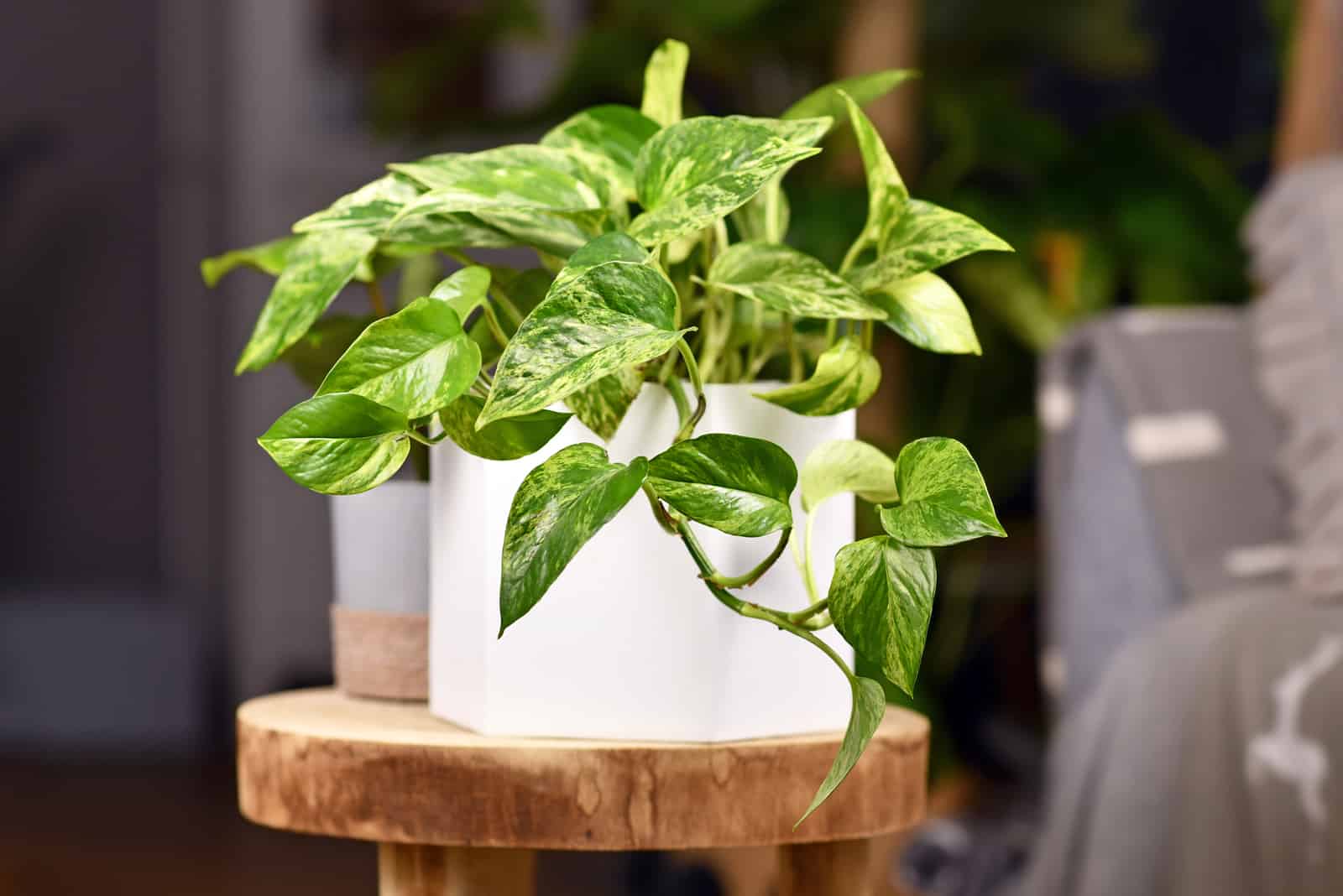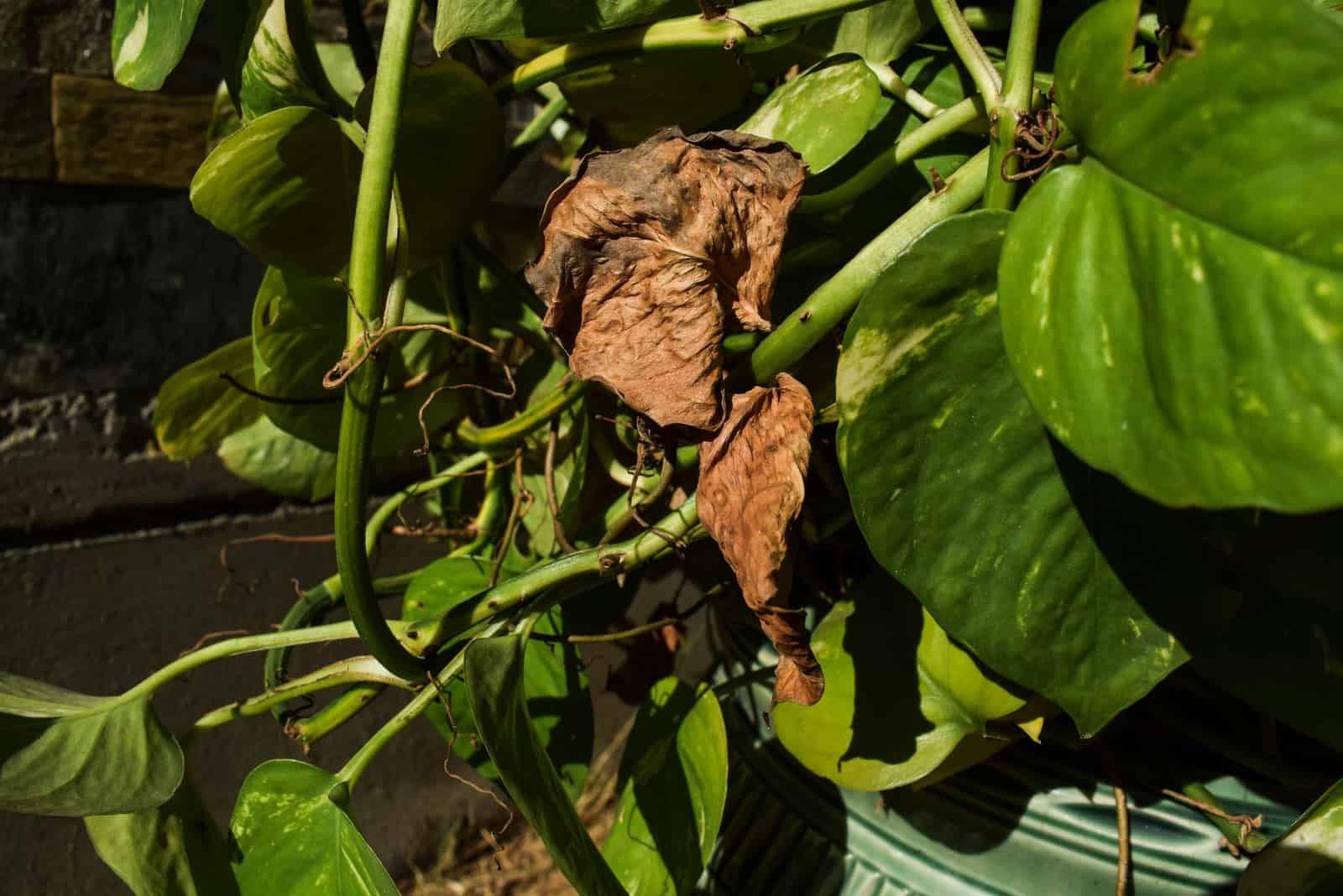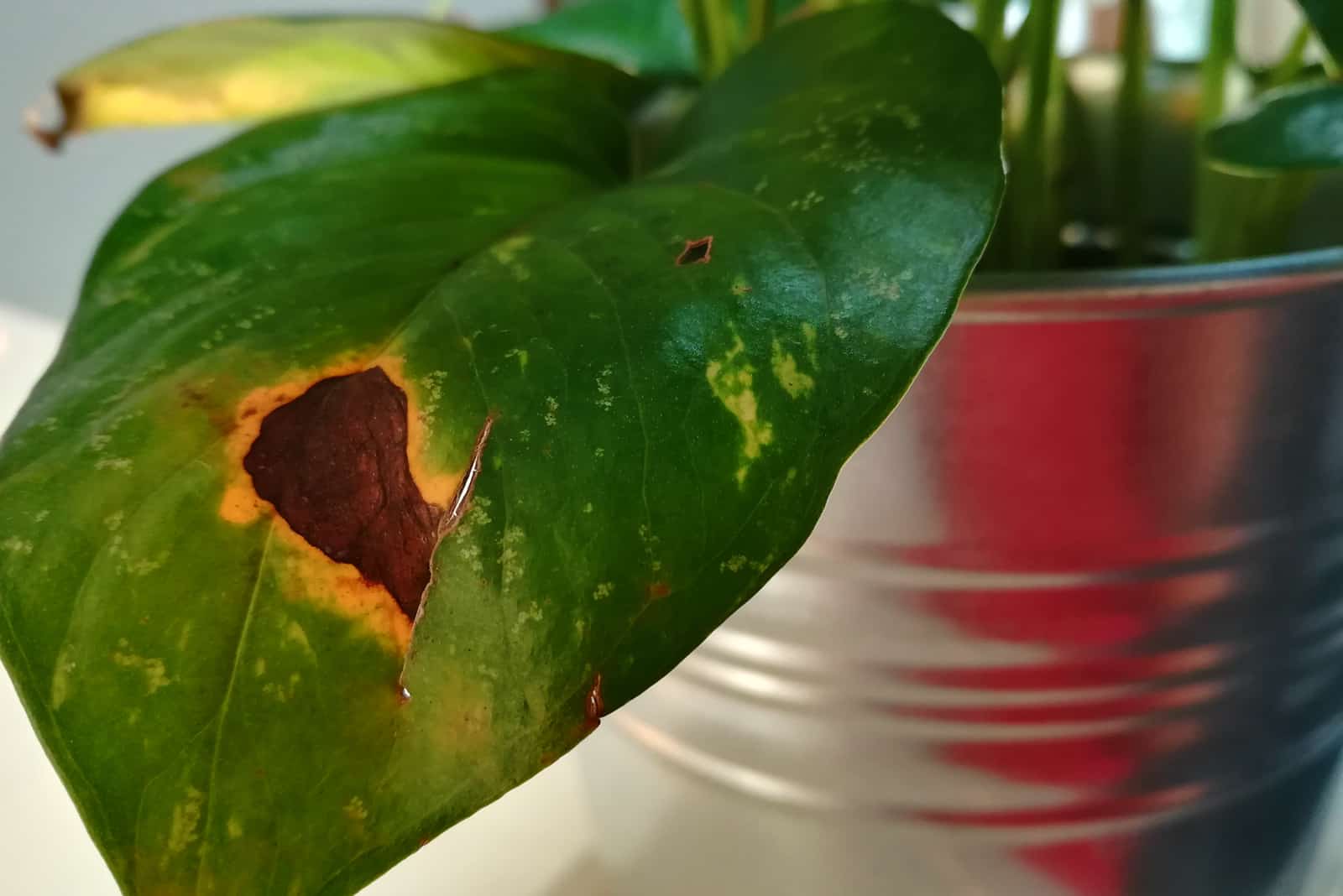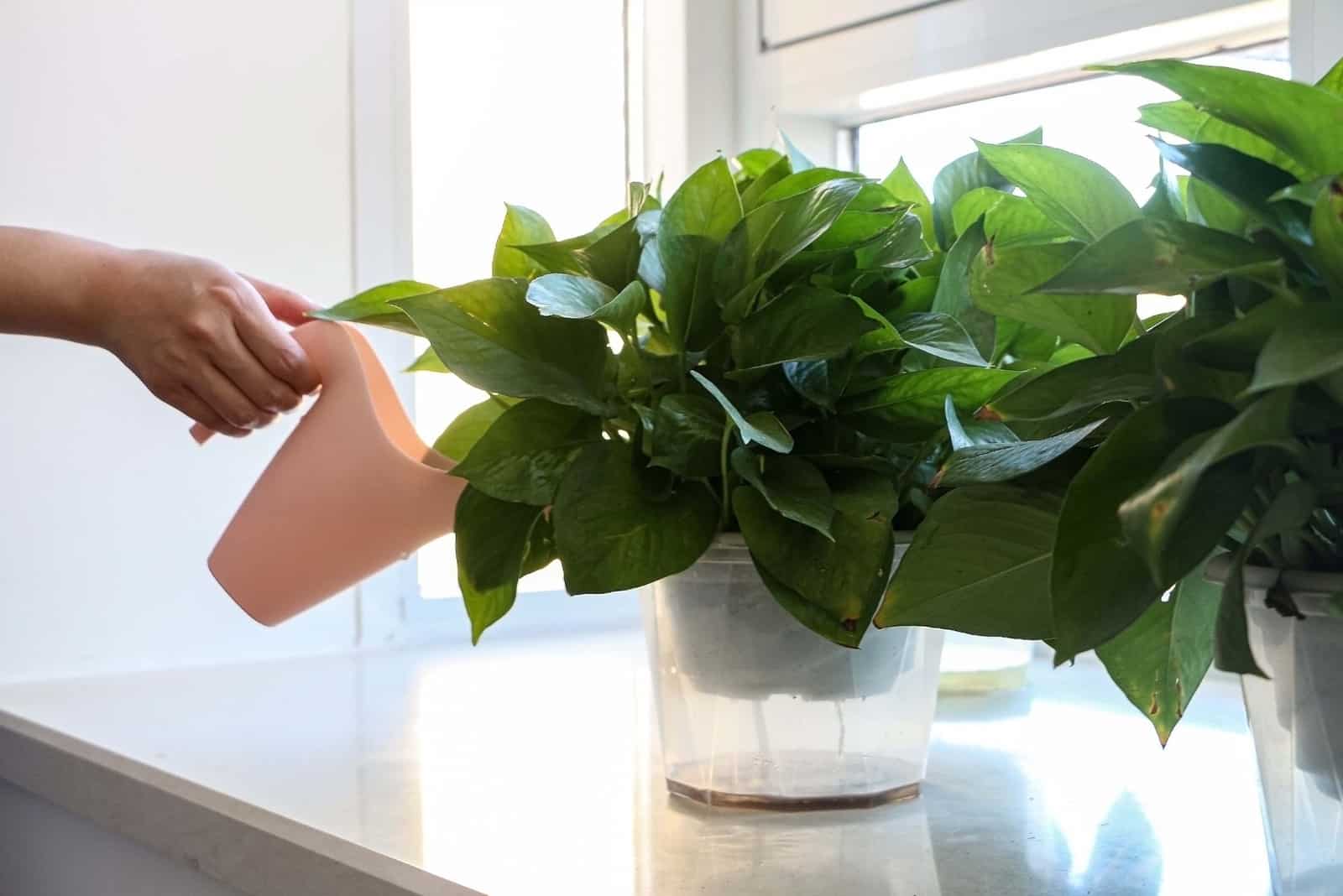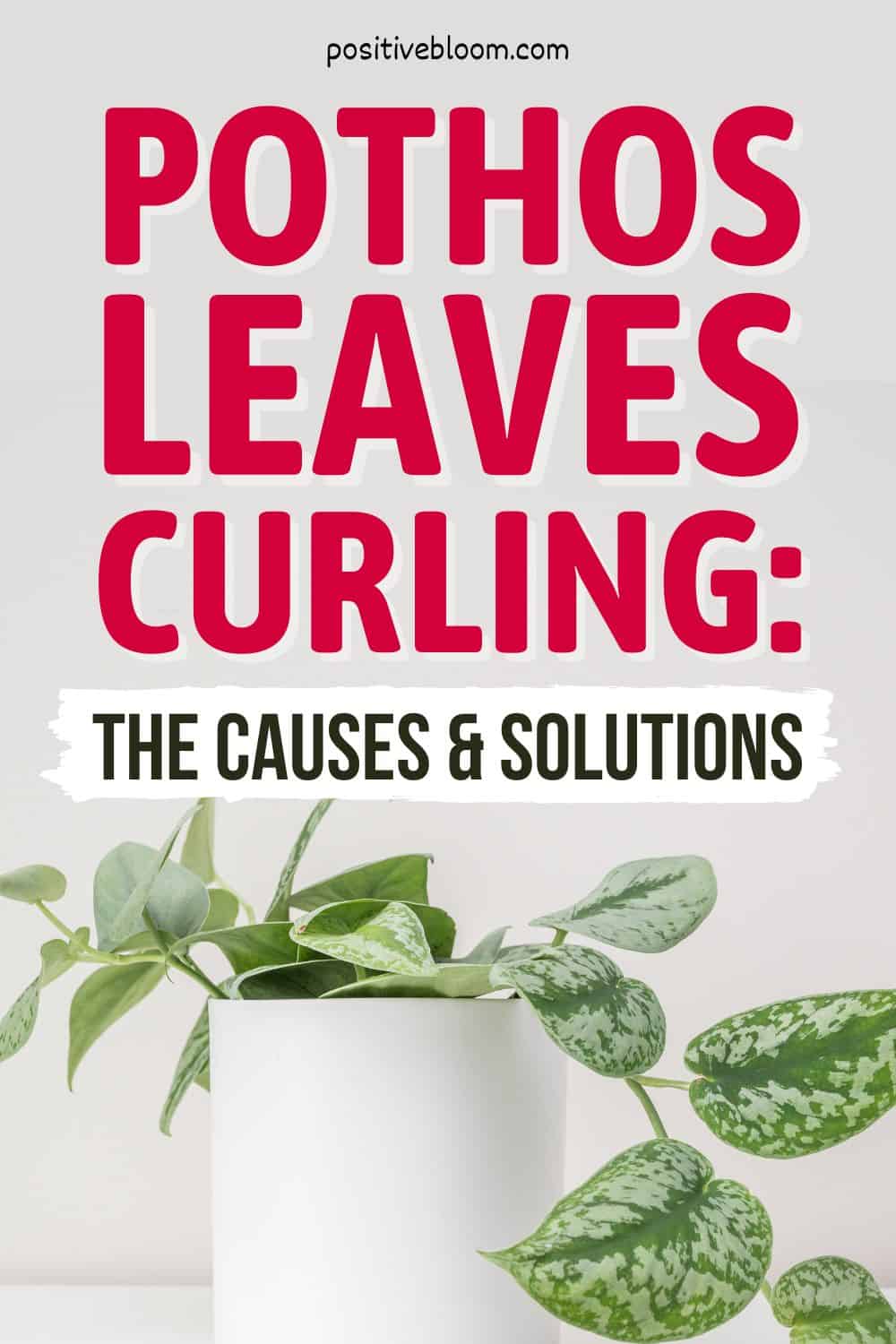Pothos are known for being easy to care for and hardy houseplants, so it can be pretty surprising when you notice changes in their appearance. These changes are often related to discoloration, wilting, drooping, or curling.
The eye-catching pothos leaves aren’t likely to change if all the conditions they require are provided. So, if you notice pothos leaves curling you should act immediately as it could lead to severe damage if left untreated.
There are many possible causes of leaves curling, so you’ll probably need some time to figure out the culprit.
Watering, fertilizing, pest infestation, temperature, humidity, and light are the chief suspects here. However, the leaves could also be curling due to the natural processes of the plant life cycle.
We’ve covered it all right here, so let’s dive straight in!
Why Are My Pothos Leaves Curling?
If something is wrong with your satin pothos, the leaves will curl, turn yellow, brown, droop, or wilt. We will look closely at what can cause curly leaves. but it’ll be easier to determine which particular cause affected your plant if some of the other symptoms appear along with curling.
Excess water in the soil, dry soil, pests, overfeeding, or incorrect conditions are the most likely culprits of the leaves curling.
The plant may also be aging or growing new leaves, which are both common causes of curling.
Let’s get into details!
Root Rot Due To Overwatering
Unfortunately, it’s pretty easy to overwater houseplants. There are several reasons: overreliance on a watering schedule, too much water used when watering, not letting the soil dry between waterings, or simply applying the wrong watering method (yes, it’s possible).
If you overwater the soil, remember that the excess water won’t dry quickly, but instead will be retained in the soil until it finds a way out.
Typically, the excess water comes out of the drainage holes, but it will stay in the soil if it’s blocked.
The only way out in this case is by evaporating, and the waterlogged soil attracts pathogens like fungus. Fungus needs a lot of water to spread, so overwatering is the worst thing you can do.
The air spaces in the soil are full of oxygen and the roots need oxygen to grow healthily. Additionally, the roots send nutrients and water to the other parts of the pothos like the leaves.
Rotten roots can’t supply the leaves with water or nutrients, so they dehydrate and curl.
You can revive your Devil’s Ivy plant if you spot the earliest signs of root rot, but if the disease spreads to other parts of your plant the chances of saving it are unfortunately very low.
There are some other symptoms you’ll see along with curling if the plant is overwatered, so let’s have a look.
What Does An Overwatered Pothos Look Like?
Root rot and curly leaves are not the only symptoms of overwatering.
Here’s a list of other symptoms that indicate the soil is waterlogged.
• Brown spots on the leaves: Too much water causes the cells to swell, creating blisters that form brown lesions.
• Mold on the soil’s surface and an unpleasant smell: Spores develop due to waterlogged soil, causing a white coating on the surface. A foul odor often follows moldy soil.
• Yellow leaves: The roots cannot send nutrients due to overwatering, causing the leaves to turn yellow. The older leaves are most likely to show this sign first.
• Wilting Devil’s Ivy: Roots are fundamental for plant survival, so a plant will wilt without healthy roots and might eventually die off.
Underwatering
Many plant growers, especially beginners, are sometimes too careful when watering due to the fear of overwatering.
However, both too little water and waiting to water for too long may cause issues that can be fatal if left untreated.
Scientifically speaking, underwatering causes the plant to lose turgor, a biological component responsible for making the pothos plant tissue rigid. When the leaf tissue isn’t rigid, the leaf starts curling.
Plant growers have a simplified version of the definition: the leaves are curling as a response to the water deficiency, i.e. to save water for later, they curl.
Pothos are plants that thrive in various conditions, even without water. They will not maintain their healthy leaves if they don’t receive water, and will continue to lose water due to the heat, which causes the leaves to curl.
This occurs primarily during the summer when the plants become increasingly thirsty and dry out due to a lack of water and excessive heat.
Water is required for any plant to thrive and retain its viability. Pothos also require regular watering to avoid soil dehydration.
Pest Infestation Or Disease
Many insects and pests can be commonly found under the leaves of pothos plants. The most common pests that attack pothos are spider mites and mealybugs. They can be harmful to your pothos plant, especially if bugs and insects are discovered under newly developing leaves.
If you’re giving your plant sufficient care, but still observe a lot of bugs, it is most likely the cause of curling pothos leaves.
Pests and insects feed on plant sap and suck up all the nutrients required for healthy leaf growth. If the infection is severe, the food flow from the stem to the leaves may be completely cut off, which causes the leaves to droop and curl.
Pests mostly hide on the undersides of the leaves, which is why they are difficult to locate. A portable LED flashlight is advised for inspecting the plants regularly.
Because spider mites are so tiny, it’s probably best to examine your pothos with a magnifying lens.
Overfertilizing
Most people think that the more fertilizer they add, the faster and better growth will be.
Unfortunately, that’s not the case.
Even though fertilizer helps the plant grow healthily and with a better growth rate, constant feeding or overfeeding will have the opposite effect.
How come? Well, each plant requires a specific amount of fertilizer and different nitrogen, phosphorus, and potassium ratios.
Overfeeding your pothos plant will create a higher concentration of harmful salts and nitrogen than the plant needs (build-up of minerals).
Excess nutrients will cause the plant’s leaves to curl downwards, reduce in size, and become discolored. These symptoms, along with curling, are yellow and drooping leaves, white soil surface, and sometimes root rot.
Fertilization means giving your plant a boost to promote its metabolism. However, overfeeding the plant actually means forcing its metabolism to work.
In the beginning, the roots will send the nutrients to the leaves faster. However, this ability will significantly decrease over time, or more simply, excess fertilizer will cause the roots to stop functioning.
Temperature Shock
If you notice the leaf tips or edges of your satin pothos plant’s leaves are curling downwards and folding, the plant may be suffering from temperature stress.
Your pothos may grow well in high temperatures, but anything over 110 degrees Fahrenheit may affect the plant and even have fatal consequences if left untreated.
When the plant is in a room with high temperatures, its leaves will curl to save themselves from the heat. This also reduces their surface area for photosynthesis.
If exposed to high temperatures, the leaves are prevented from transpiring and eventually dehydrate as the heat reduces moisture.
As you can see, most issues related to the plant’s appearance are caused by poor conditions.
Too Much Or Too Little Light Exposure
An appropriate light level is key to the healthy growth of your pothos. Most houseplants need the same light levels, but some can survive in higher or lower light.
With pothos, the situation is slightly different. The satin pothos is native to French Polynesia where the forests are covered with tall trees, so the plants don’t receive direct sunlight.
The pothos plant requires 8 to 10 hours of bright indirect sunlight per day. It helps them perform photosynthesis, preserve variegation, and ensure an adequate supply of water and nutrients.
Direct sunlight damages the plant cells essential for photosynthesis. If the plant is exposed to direct sun for an extended period its leaves will curl then fall off, so there’s no chance for recovery.
Pothos won’t react well to low light either, which will prevent photosynthesis. As a result, the entire plant will have a wilting appearance.
These plants require bright indirect light, so both direct and too little light can lead to damage.
Luckily, it’s easy to check if light is the problem or cause of leaf curling. Leaves grow or extend to the light source, so if the leaves of your pothos are stretching towards the light source, they aren’t receiving enough sunlight.
On the other hand, if pothos leaves curl away from the light source, they are receiving too much direct sunlight.
Low Humidity
Dry air or low humidity will cause the soil to lose water faster. Consequently, the leaves won’t have access to water and will respond by curling as they want to preserve as much water as possible.
You’ll know that the plant is lacking humidity if the potting mix is dry, but the plant will also have a wilting appearance, look dull, and lose variegations.
Read on to discover some ways to increase humidity.
New Leaves Or Aging
Pothos leaves curl as a natural part of their life cycle. For example, older leaves will curl, turn yellow and brown, die, and eventually fall off.
When new leaves grow they may be curly, but they mainly curl inwards. There isn’t any particular reason for this, so there’s no need to panic! New growth and leaf curl aren’t a sign of concern, but actually a sign of a healthy pothos!
Lastly, a pothos may need time to adjust when repotted or transplanted. Repotting or transplantation shock may cause leaf curl, brown or yellow leaves, and drooping.
The key is not to disturb the plant’s roots when transplanting or repotting, and ensure adequate conditions.
Solutions To Pothos Plant Leaves Curling
Now that you know the most common reasons for pothos leaves curling, you can determine the one responsible for your own plant.
Although it may seem like there’s no hope when your plant’s appearance changes, there’s always a chance of recovering it.
It’s essential to continue with care after you check the conditions and adjust them to the needs of your pothos.
If your plant has issues caused by inadequate watering, you’ll need to change your watering habits. The same applies to fertilizers. Light, moisture, and temperature can be monitored using devices I’ll show you later, and root rot and pests need to be removed immediately.
Let’s find out how to fix your Epipremnum aureum!
Watering
As you now know, most issues suffered by houseplants are caused by inadequate watering. You may be wondering how much water is enough at this point.
All varieties of pothos plants, such as trailing pothos, require the soil to dry out completely before the next watering.
So, if the leaf curl is caused by overwatering, you’ll need to leave the plant to dry. It will take some time, but it’s worth it. However, if you leave your pothos exposed to direct sunlight to accelerate draining, you’ll create the opposite effect. Just ensure it has the conditions it usually needs and wait patiently.
On the other hand, if underwatering causes leaf curl, you’ll need to water your precious pothos thoroughly.
Let the water come out through the drainage holes and water more often until you notice some signs of improvement. After that, it would be best if you continue with your usual watering schedule. The ideal watering schedule would be to wait for the soil to dry out completely before watering it thoroughly afterward.
The leaves may take some time to recover, but if the damage isn’t severe the chances for recovery are very high!
Unfortunately, the most serious problem a pothos suffers from is root rot. The chances for recovery significantly decrease, but the solution removes the root rot.
Let’s find out how!
How To Remove Root Rot In 3 Simple Steps
Root rot is difficult to cure once it has taken hold, and you can only save the plant by removing the dead sections (including the roots) and repotting them into fresh soil.
The plant may be beyond rescuing if the root rot is widespread and has impacted the root system and all the leaves.
If a satin pothos still has some healthy roots, it may be possible to rehabilitate it using the techniques below.
1. Remove the pothos’ soil and inspect the roots. Gently remove the satin pothos plant from its pot and break away as much soil as possible from the roots. Examine the plant’s roots and leaves and look for any rotting sections. Rotting roots are dark and mushy or stringy, while healthy roots are firm and green or white.
2. Cut any rotting roots and leaves using sterilized scissors or pruners. Be careful not to damage healthy parts of the plant. Sterilized tools will prevent the disease from spreading.
3. Repot your pothos. You should repot your plant in fresh soil after removing all of the dead or dying roots and leaves. Select a pot with drainage holes and pay close attention to the potting mix. It should be well-draining as poor drainage will reverse the process. Additionally, the potting soil for a pothos plant should retain water as this plant needs moist soil to grow healthy and thrive.
After removing root rot and repotting the plant, continue with usual pothos care.
What Is The Best Way To Water Pothos Plants?
There are two watering methods: bottom and top watering. For pothos plants, I highly recommend bottom watering.
Place your pothos in a sink filled with water and let it sit for about 10 minutes. Place the plant on a dry surface to allow it to drain efficiently.
Bottom watering is the easiest way to avoid overwatering your pothos.
This watering method will provide your pothos with enough water to grow healthy and thrive.
Remove Pests
There are several ways to get rid of these annoying and unwanted guests.
First, you can purchase pest repellent from a plant store. Pesticides have a high success rate.
You can also use homemade remedies and have the same success.
This method is trendy nowadays, and as an experienced plant grower, I always suggest using natural repellents.
You can use various things in your household like garlic spray, neem oil, soap or dishwasher liquid, and rubbing alcohol.
Natural repellents work as great insecticides, so using them is a good idea.
If you decide to use any natural repellents like garlic, neem oil, or soap/dishwasher liquid, mix them with water and spray over the affected pothos leaves.
Fertilizing Schedule
Before we move on to solving the overfeeding problem, you have to determine the level of overfertilization your plant is suffering from.
No extreme measures are required if you are only slightly overfertilizing. Simply cease feeding your pothos plant for a few months.
Once the plant has returned to normal, begin feeding it in small amounts that gradually increase as the plant grows.
On the other hand, if you were giving significantly more fertilizer than was required, you should uproot the pothos plant and brush out all of the soil surrounding the roots. After that, you should repot your pothos plant.
As pothos are low-maintenance plants, their fertilizing schedule is simple. Apply all-purpose fertilizer for indoor plants once or twice a month and dilute it to half a strength to avoid burning your pothos.
Adjust The Light
If they don’t get enough light, variegated plants might lose their leaf pattern and end up with all-green leaves.
Luckily, fixing problems with light is straightforward. For example, you can use a light meter to monitor light levels.
If light levels are low, here’s what you can do:
• Consider investing in grow lights. They are an easy and safe method of fixing light issues.
• Move your pothos closer to a window that receives enough light.
• Place your pothos under a lamp to ensure it gets sufficient light.
If your pothos receives too much light, the solution is moving it away from windows or any other light source. However, you can place this plant near a window that gets direct sunlight, but you should use sheer curtains to create partial shade.
After fixing the light issue, give your pothos some time to adapt and the leaves should get back to normal soon.
Adjust The Temperature
If you grow a pothos plant outdoors, you should find a spot in your garden that has partial shade.
When grown as an indoor plant, pothos plants prefer a room temperature of 65 to 75 degrees Fahrenheit.
As pothos are sensitive to high temperatures, keep them away from heating sources like radiators, fireplaces, or air conditioners.
Adjust Humidity Levels
Most houseplants are tropical and require higher humidity levels.
Here are five ways to increase humidity levels for your pothos plant.
1. Grouping the plants: Transpiration is the mechanism by which plants shed moisture through their leaves. Plants can be grouped to generate a more humid microclimate in places they grow, which benefits all of them.
2. Use a pebble tray: Place some pebbles in a tray then put the plant pots on top of the stones. Fill the tray halfway with water, but be careful not to submerge the pots as this may induce root rot.
3. Misting: Spray the plants using a spray bottle filled with clean water. Misting is especially beneficial during the start of the winter season as the humidity reduces fast because of the temperature dropping.
4. Humidifier: Humidifiers will enhance humidity levels throughout the entire room, but they are particularly useful in a growing setting.
5. Terrarium: A terrarium is a tiny container filled with dirt and a few small plants. The system is sealed, so the plants absorb moisture and “exhale” it through transpiration. Moisture then collects on the terrarium’s walls before falling back into the growing media. This imitates the natural water cycle. If you grow smaller plants, this method is perfect.
Wrapping Up
The pothos is undoubtedly among the most beautiful houseplants. Even though it’s unusual for their leaves to curl, it can happen for a few reasons.
Pothos leaves curling may be caused by inadequate water supply, overfeeding, pests, too much or too little light, high temperature, and low humidity. However, pothos leaves may also curl as part of their natural life cycle.
It’s essential to determine the cause of curling as soon as possible as it will increase the Devil’s Ivy’s chances of recovery.
Remember that providing the plant with the right conditions is all you need to do in order to see it happy and thriving.
This is a low-maintenance plant, so satin pothos plant care won’t take too much of your time.
Until next time!
Like this post? Share or pin it for later!

